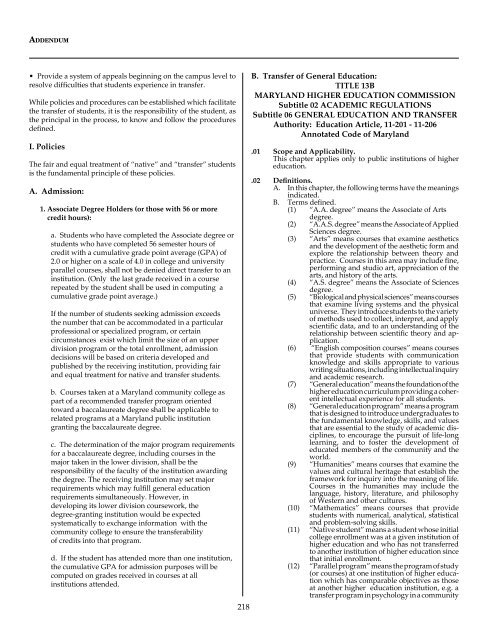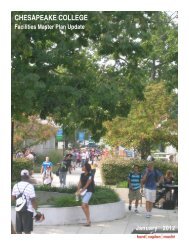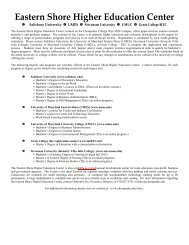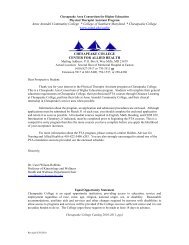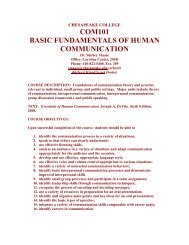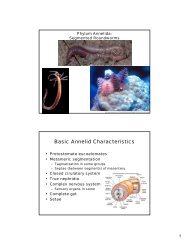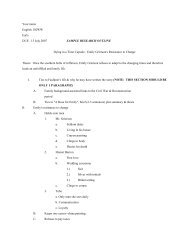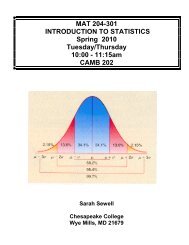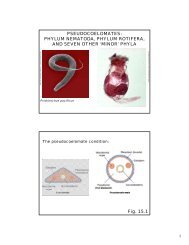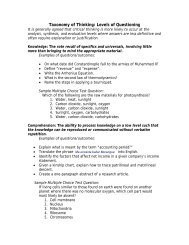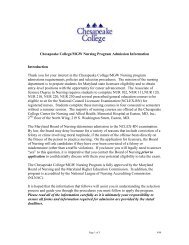Academic Calendar 2011-2012 - Chesapeake College
Academic Calendar 2011-2012 - Chesapeake College
Academic Calendar 2011-2012 - Chesapeake College
Create successful ePaper yourself
Turn your PDF publications into a flip-book with our unique Google optimized e-Paper software.
Addendum• Provide a system of appeals beginning on the campus level toresolve difficulties that students experience in transfer.While policies and procedures can be established which facilitatethe transfer of students, it is the responsibility of the student, asthe principal in the process, to know and follow the proceduresdefined.I. PoliciesThe fair and equal treatment of “native” and “transfer” studentsis the fundamental principle of these policies.A. Admission:1. Associate Degree Holders (or those with 56 or morecredit hours):a. Students who have completed the Associate degree orstudents who have completed 56 semester hours ofcredit with a cumulative grade point average (GPA) of2.0 or higher on a scale of 4.0 in college and universityparallel courses, shall not be denied direct transfer to aninstitution. (Only the last grade received in a courserepeated by the student shall be used in computing acumulative grade point average.)If the number of students seeking admission exceedsthe number that can be accommodated in a particularprofessional or specialized program, or certaincircumstances exist which limit the size of an upperdivision program or the total enrollment, admissiondecisions will be based on criteria developed andpublished by the receiving institution, providing fairand equal treatment for native and transfer students.b. Courses taken at a Maryland community college aspart of a recommended transfer program orientedtoward a baccalaureate degree shall be applicable torelated programs at a Maryland public institutiongranting the baccalaureate degree.c. The determination of the major program requirementsfor a baccalaureate degree, including courses in themajor taken in the lower division, shall be theresponsibility of the faculty of the institution awardingthe degree. The receiving institution may set majorrequirements which may fulfill general educationrequirements simultaneously. However, indeveloping its lower division coursework, thedegree-granting institution would be expectedsystematically to exchange information with thecommunity college to ensure the transferabilityof credits into that program.d. If the student has attended more than one institution,the cumulative GPA for admission purposes will becomputed on grades received in courses at allinstitutions attended.218B. Transfer of General Education:TITLE 13BMARYLAND HIGHER EDUCATION COMMISSIONSubtitle 02 ACADEMIC REGULATIONSSubtitle 06 GENERAL EDUCATION AND TRANSFERAuthority: Education Article, 11-201 - 11-206Annotated Code of Maryland.01 Scope and Applicability.This chapter applies only to public institutions of highereducation..02 Definitions.A. In this chapter, the following terms have the meaningsindicated.B. Terms defined.(1) “A.A. degree” means the Associate of Artsdegree.(2) “A.A.S. degree” means the Associate of AppliedSciences degree.(3) “Arts” means courses that examine aestheticsand the development of the aesthetic form andexplore the relationship between theory andpractice. Courses in this area may include fine,performing and studio art, appreciation of thearts, and history of the arts.(4) “A.S. degree” means the Associate of Sciencesdegree.(5) “Biological and physical sciences” means coursesthat examine living systems and the physicaluniverse. They introduce students to the varietyof methods used to collect, interpret, and applyscientific data, and to an understanding of therelationship between scientific theory and application.(6) “English composition courses” means coursesthat provide students with communicationknowledge and skills appropriate to variouswriting situations, including intellectual inquiryand academic research.(7) “General education” means the foundation of thehigher education curriculum providing a coherentintellectual experience for all students.(8) “General education program” means a programthat is designed to introduce undergraduates tothe fundamental knowledge, skills, and valuesthat are essential to the study of academic disciplines,to encourage the pursuit of life-longlearning, and to foster the development ofeducated members of the community and theworld.(9) “Humanities” means courses that examine thevalues and cultural heritage that establish theframework for inquiry into the meaning of life.Courses in the humanities may include thelanguage, history, literature, and philosophyof Western and other cultures.(10) “Mathematics” means courses that providestudents with numerical, analytical, statisticaland problem-solving skills.(11) “Native student” means a student whose initialcollege enrollment was at a given institution ofhigher education and who has not transferredto another institution of higher education sincethat initial enrollment.(12) “Parallel program” means the program of study(or courses) at one institution of higher educationwhich has comparable objectives as thoseat another higher education institution, e.g. atransfer program in psychology in a community


